The no-BS guide to great content marketing: part 2
In the first part of this guide, I discussed the what and the why of content marketing. I gave a straightforward definition of content and four compelling reasons to use it to grow a business:
- Boost in search engine rankings
- Amplification of business relationships
- Brand image improvement
- Leads & revenue generation
Now, I'm going to cover the most important part: the how.
This second part of the guide will walk you through the process of planning, researching, crafting and improving good content marketing. It's mostly based on my 3 years of hands-on experience at our developer-first e-commerce startup. But I'll also throw in lessons & tips from other killer content marketers.
Note: the third and last part of the guide (coming soon enough), will discuss content distribution & performance analysis.
Let us begin, friends.
Follow along with the complete slide deck for funny gifs and supporting visuals.
1. Planning your content efforts
Before you start producing content, I recommend coming up with a content minimum viable plan (MVP). I wrote a full post on how to lay strategic foundations for your content. If you haven't read it, check it out before you go on:
Our PM at Snipcart also shared with me this Content Strategy Canvas by Chris Lake:
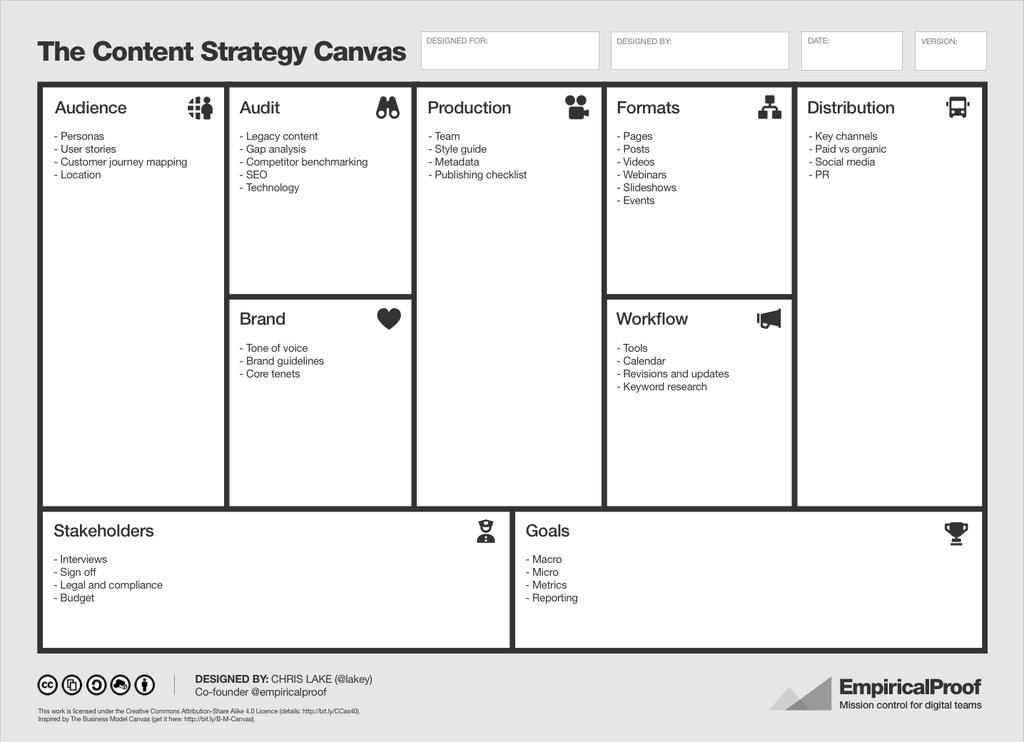
It's a helpful resource to come up with a lean strategy outline for your content efforts. You can read the post introducing his Content Strategy Canvas tool. I also shared a Content Marketing Plan template in my previous post. Check them both out, and use the one you feel the most comfortable with.
2. Crafting your content
2.1 - Generating ideas
If you went through the strategic exercise of defining your user persona and buyer journey, this shouldn't be an exhaustive endeavor. I discussed this in the Content Marketing MVP post mentioned earlier.
First, create a Trello board where you can store and categorize content ideas. Here's a snapshot of the one I maintain for Snipcart:
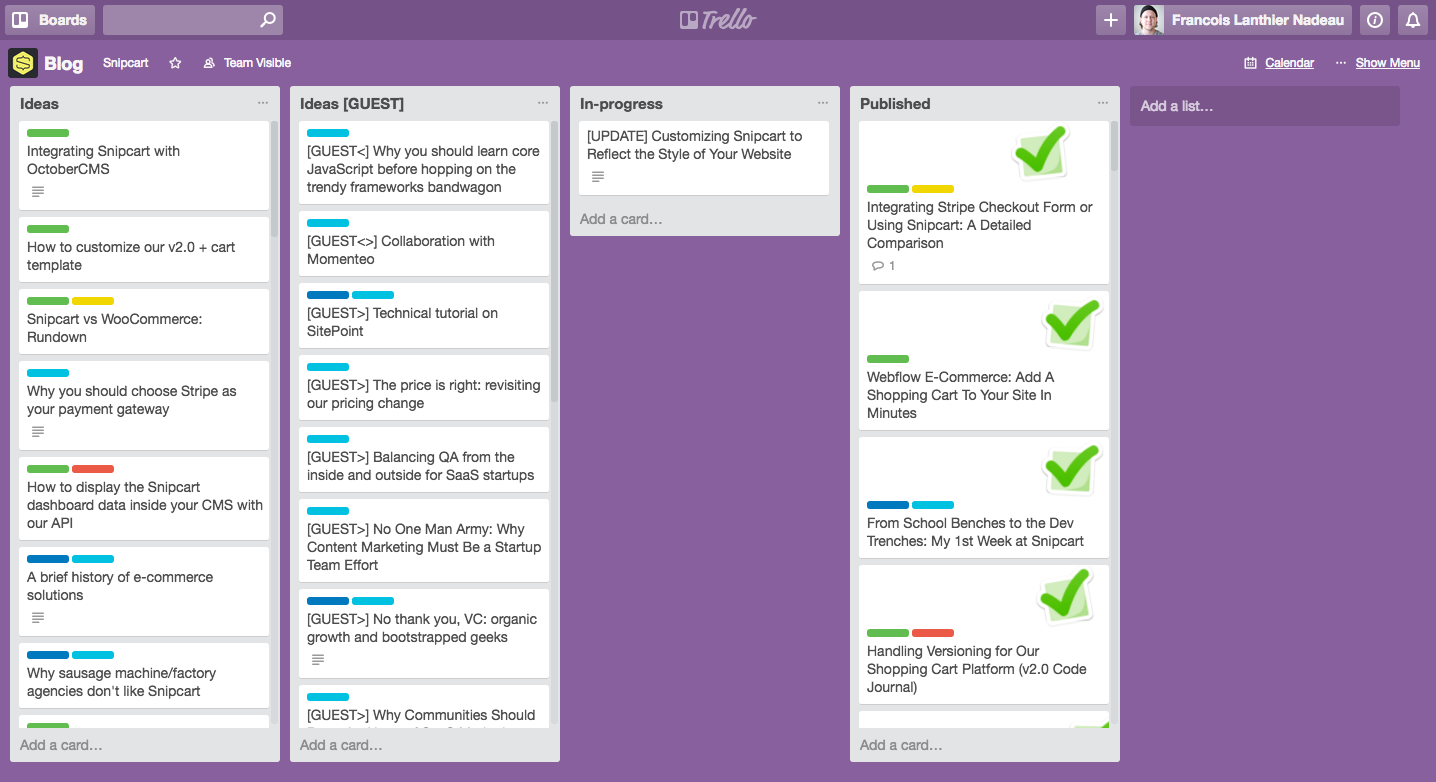
I try to categorize posts depending on which steps of our conversion funnel they address (some steps often overlap for one piece of content).
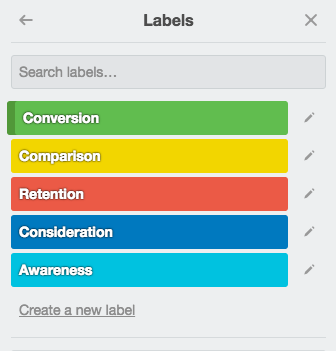
Once you have a board set up, start by asking yourself a few questions:
TOFU (top-of-the-funnel) content: awareness
What everyday challenges do your potential users face? How can you help them overcome?
What’s going on in your industry? What do you think about it?
How can your audience members be better at what they do or love?
"We the best" content: consideration
What particular pains is your audience experiencing? How can your product ease them?
Who are you, really? How do you operate? Why should we care?
In what ways is your product innovative or different?
CC trigger content: comparison & conversion
What amazing stuff have your customers done recently with your product? Show us.
What new features or products are you working on? Why does it matter?
How can we use your product to get killer results?
How well does your product play with other tools & existing workflows?
Why should we choose your product over your competitors'?
Sticky stuff content: retention
How can we make the most out of your product?
What else can you do for me now that I'm onboard/paying?
How can you turn us into product ambassadors, not mere users?
Want to get more serious about mapping content to conversion funnel steps? Check out Steven Peters' Every Type of Digital Content (for Every Stage of the Buyer’s Journey) post.
Running out of ideas? Alex from Groove published a cool article helping to generate content ideas a while back. It's still relevant, and might come in handy.
Generating content ideas is a team effort
At Snipcart, I realized that it was paramount to keep this idea pool opened to the whole team. All our different team members hover into different spheres of our business (biz dev, customer support, HR, PM, dev, marketing, etc.). And since we all share a content mindset, each one has a unique input into content ideas. This way, our pool's never empty; it's overflowing.
2.2 - Researching content
I'd be lying if I told you I follow the same routine every time I research content. Depending on my piece's topic and goal, tools and techniques vary.
Following the "add value, not noise" mantra, I often suggest getting a feel for a thematic landscape before crafting content. To do so, start by generating 3-5 variations of a piece title. Then, Google them, plain and simple.
Read the 2-3 top relevant articles ranking for your title variations. Soak in the lingo, and try to identify recurring points. You can also use BuzzSumo to find which pieces of content have performed the most on social media for a given theme & period. BuzzSumo research will also provide info on key influencers (content creators + top sharers) that might help later on.
Then, try to identify content gaps: points that haven't been discussed, or to which you can bring a unique touch. If you're tackling popular themes, talking about your own experience might provide the level of authenticity great content needs. This is why "story" or "case study" posts are often well-received and get good results.
Note: for more research-heavy content crafting, give this Belle Beth Cooper long-form post a read.
Once I've done the above, I try to include two important research angles before I start creating content:
A) How will I optimize this post for SEO?
I tend not to prioritize SEO over theme and content value for my audience. But still, ranking organically—if you have a shot—can bring in amazing results.
Let's use a post I'd write for my friends at Momenteo, a SaaS accounting for freelancers, as an example. Say I've already settled on a post about using content marketing & SEO to get more freelancer gigs.
My original title would be something like: "Get Client Work with Content Marketing & SEO"
First, I'll use Keyword Tool to test traffic volume for different title and keyword variations.
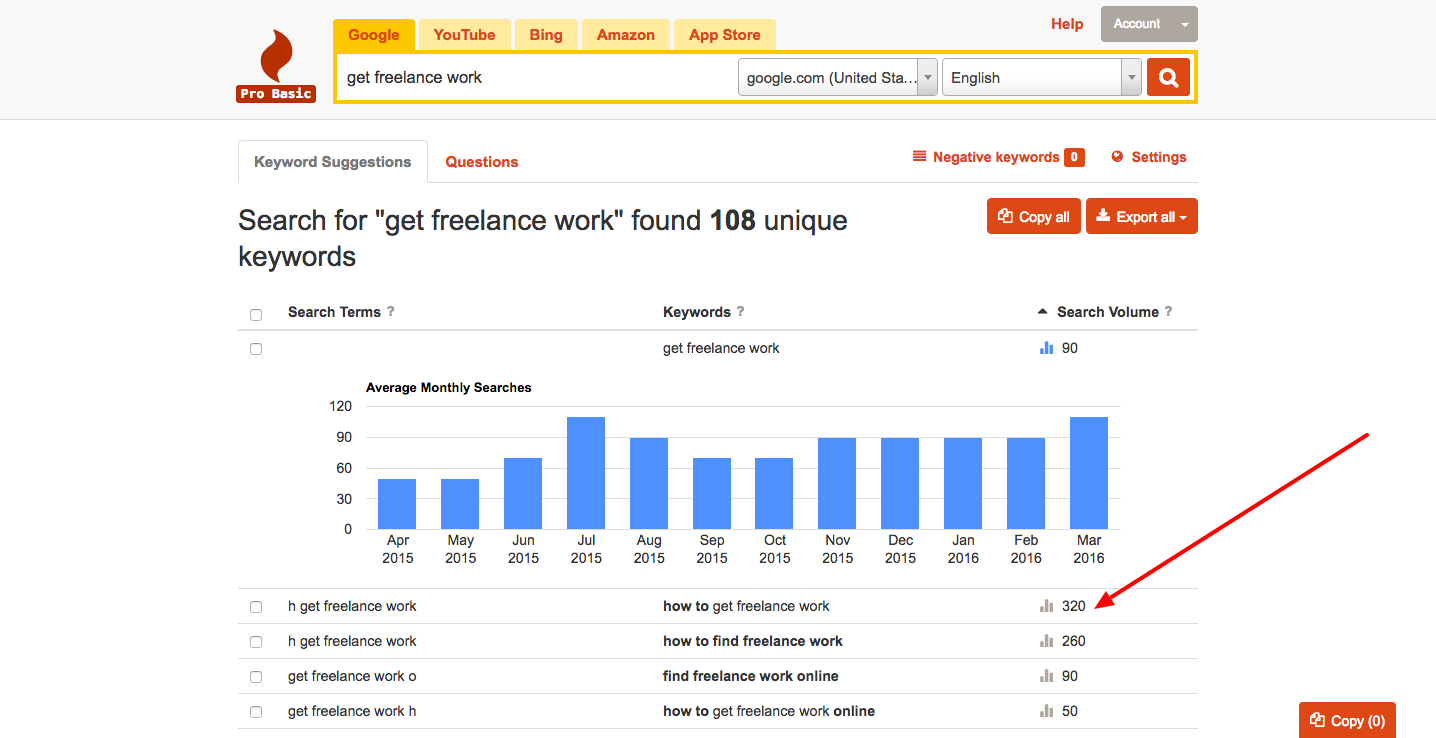
Playing around with the tool quickly informed me I better use freelance work than client work; the latter has less search volume than the former. It also confirmed that how to get freelance work was more popular than how to find freelance work. It showed me that with the verb get, more organic traffic was flowing towards a longer-tail and question-based keyword (how to get [...] > get [...]).
But I also discovered that, for shorter-tail formulations, find received way more search volume.
So I'm left with two new potential titles:
"Find Freelance Work with Content Marketing & SEO"
"How to Get Freelance Work with Content Marketing & SEO"
To decide which one I'll use, I analyze the level of competition on the SERP. In other words, I ask myself: Will I be able to rank on the first page for these keywords? So again, I Google my titles, and activate MozBar to see the authority of the pages and domains ranking on the first page.
Here, the latter had more "vulnerable" first page spots.
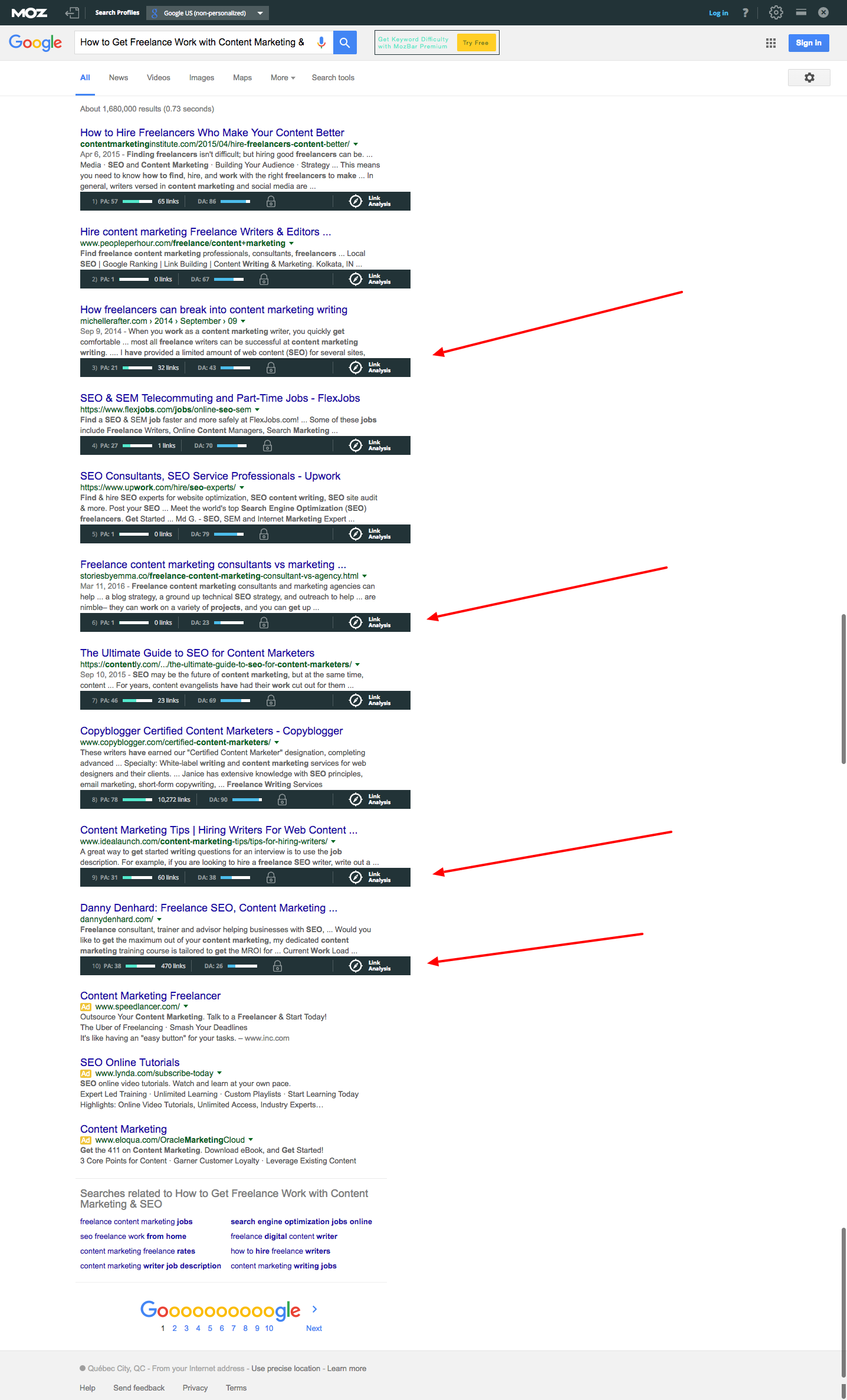
However, I also realized that the type of content Google served for my titles didn't correspond to the search intent I targeted. As you can see in the screenshot, results are related to finding jobs in the field of content & SEO; not finding client work using these techniques.
So here, I'd pick a keyword with less search volume, but that fits perfectly with the search intent my post targets. I could pivot to "how to get freelance clients" instead of "how to get freelance work" for instance.
Always go for more niche results at first. SaaStr founder Jason Lemkin said pretty much the same thing in this cool Heavybit podcast, and I couldn't agree more. You're better off driving less organic traffic that's actually interested in your content than lots of visitors that bounce has soon as they hit your page. To make sure your content corresponds to search intent, you can also use the Google search hack.
Now, time for a short warning. It's easy to fall for the "if I rank for [keyword] I'm gonna drive so much traffic" fallacy and to make this the focus of your content.
And if we're being honest, I committed the mistake of putting keyword targeting in front of search intent and the user's interest a few times. Yeah, some of my posts ranked first page. Woohoo. But my click-through and bounce rate were both awful. And conversion? 0%.
B) Where and to whom will I promote this post after publication?
Finding influencers & communities
This part may greatly vary depending on the time you have on your hands. It's best to handle this early on in your workflow. It'll give you an opportunity to participate in targeted communities, and connect with collaborators and influencers before publishing your content. This will increase your chances of getting good reception when you share your content with them.
Influencers
There are already many comprehensive posts on how to do influencer marketing and outreach out there. I won't be covering the topic in depth here. The key is to find people with a relevant audience and significant reach to help promote your content. To be 100% honest with you, I mostly do this the old-fashioned way (the more natural and organic my outreach efforts, the more long-lasting benefits I get). I Google around my topic and theme, spot authors or top-commenters on related articles, find their contact info, and try to connect with them via their blog, Twitter or email. I ask for their feedback, thoughts, or simply thank them for providing content that inspired mine.
That's how I found this potential influencer for the freelancing post I used in the previous example.
I suggest reading this article on email outreach for content marketing by Sujan Patel. It also has 3 helpful email templates you can copy and use for your own efforts. And here's one of mine:
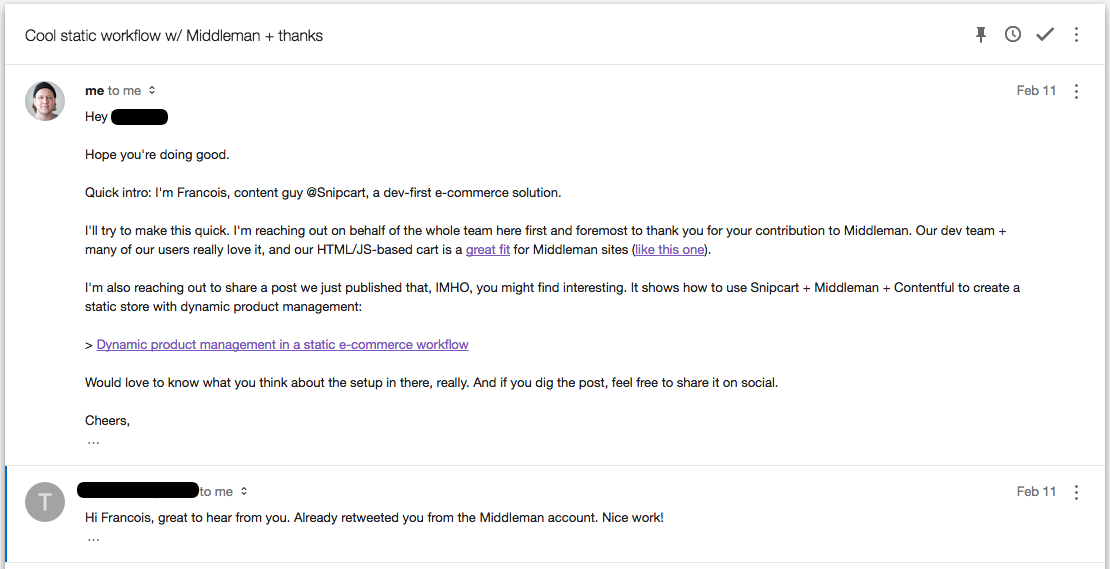
If you're serious about building mutually beneficial relationships for your outreach efforts, check out this engagement plan for influencers.
There are many tools to help you identify influencers and connect with influencers. Buzzsumo and ContentMarketer.io are some of the most popular.
Communities
Now, to find relevant communities to promote your content, try to put yourself in the shoes of your reader. Where would I go hang out and connect with fellow X enthusiasts?
A few questions that can help in the outreach process here:
- Is there a chat somewhere?
Use Slack List or Chit Chats to help you here.
- Are there forums & communities dedicated to my type of content?
Sharing my Content Marketing MVP post with inbound.org (inbound marketing community), for instance, brought hundreds of extra views to it. Eventually, it helped me publish a cool guest post for their Originals section.
- Are there blogs that cover my topics?
If so, can you connect with the readers or the author via social media, or the comments section?
- Are there social groups dedicated to my topics?
A quick search through Facebook groups, LinkedIn groups, Google+ communities and Reddit's subreddits is sure to be helpful here.
- Can I find directories or lists of resources where my content could be featured?
That could make for a sweet evergreen content placement (+ a backlink)!
Content research sum-up
You should approach the whole research part of your content marketing with one key idea in mind:**
Maximizing both the outbound efforts of outreach and inbound potential of SEO.
Of course, that's a best of both worlds scenario. Sometimes you'll get great promotional results with a witty editorial piece that, unfortunately, isn't able to rank for traffic-intensive queries. The opposite might happen too!
2.3 - Crafting & producing content
Now that's the fun part! And I mean it: if you've done thorough topical, SEO & outreach research, content will be easy to produce.
First, make a plan.
Put together a skeleton of your article—I'm focusing on this type of content here; it's the one I'm most comfortable with. Jot down your main title (H1), sections subtitles (H2), sub-sections headers (H3).
Then, put into bullet points key ideas for each section.
In your last section, write up the main takeaways you want the reader to get from your post.
Final step of a good outline will be to gather and position your visual assets. If you don't have them yet, mark the place and alt-tag you'll use for them.
Here's a recent post outline I did for a guest post for our startup:
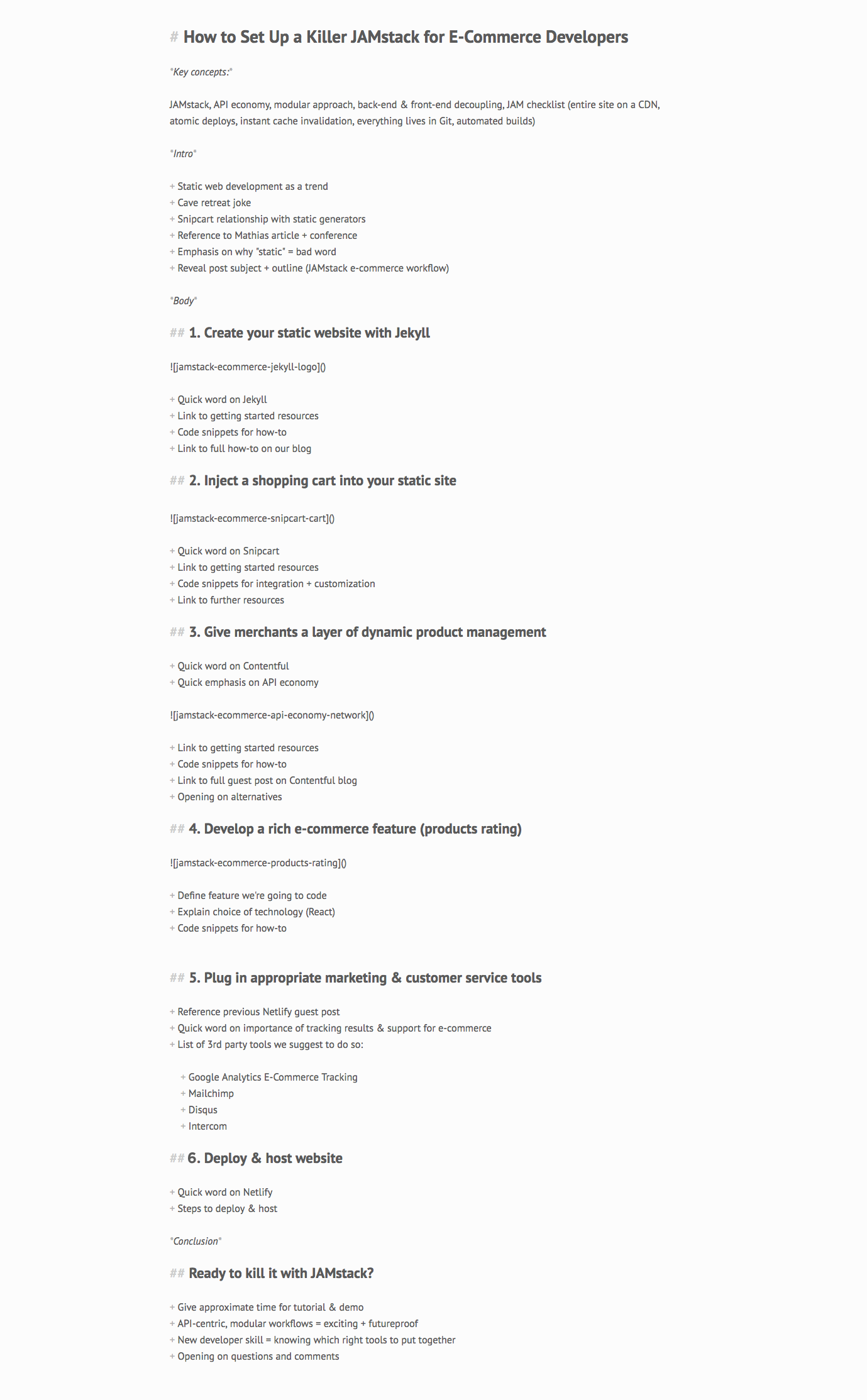
Now, create the content, AKA draw the rest of the f*cking owl.
There's no magic formula here. You have to produce the actual content!
If you're shaky at first, don't worry: practice makes perfect. After hitting publish on about 100 posts in the last years, I can confirm the initial stress goes away quickly. :)
And while you're crafting your content, make sure to keep the reader's intent and journey in mind.
The first must-do here is linking to other relevant content on your site. Will the reader be interested in a case study you've published on the article she's reading now? Will she be convinced that your product solves her pains after this post? No? Maybe link to a page listing benefits?
The internal links you'll insert here will depend on where your content positions itself in the conversion funnel (concept discussed thoroughly in this previous post).
A user session that spawns over many pages is extra good for your SEO.
So are links towards external, authoritative sources. You can learn more about internal and external linking in this Moz Whiteboard Friday.
The big question here is: where else can your audience find value? Point towards these resources, both internally and externally.
Last but not least, insert clear calls-to-action at the end of your content.
Identify what actionable results you want for your content (downloads, shares, sign-ups, subscribes, etc.). Then, make it easy for readers to convert with visually effective and cleverly written calls-to-action. Here's one simple example I really like from the Help Scout blog:
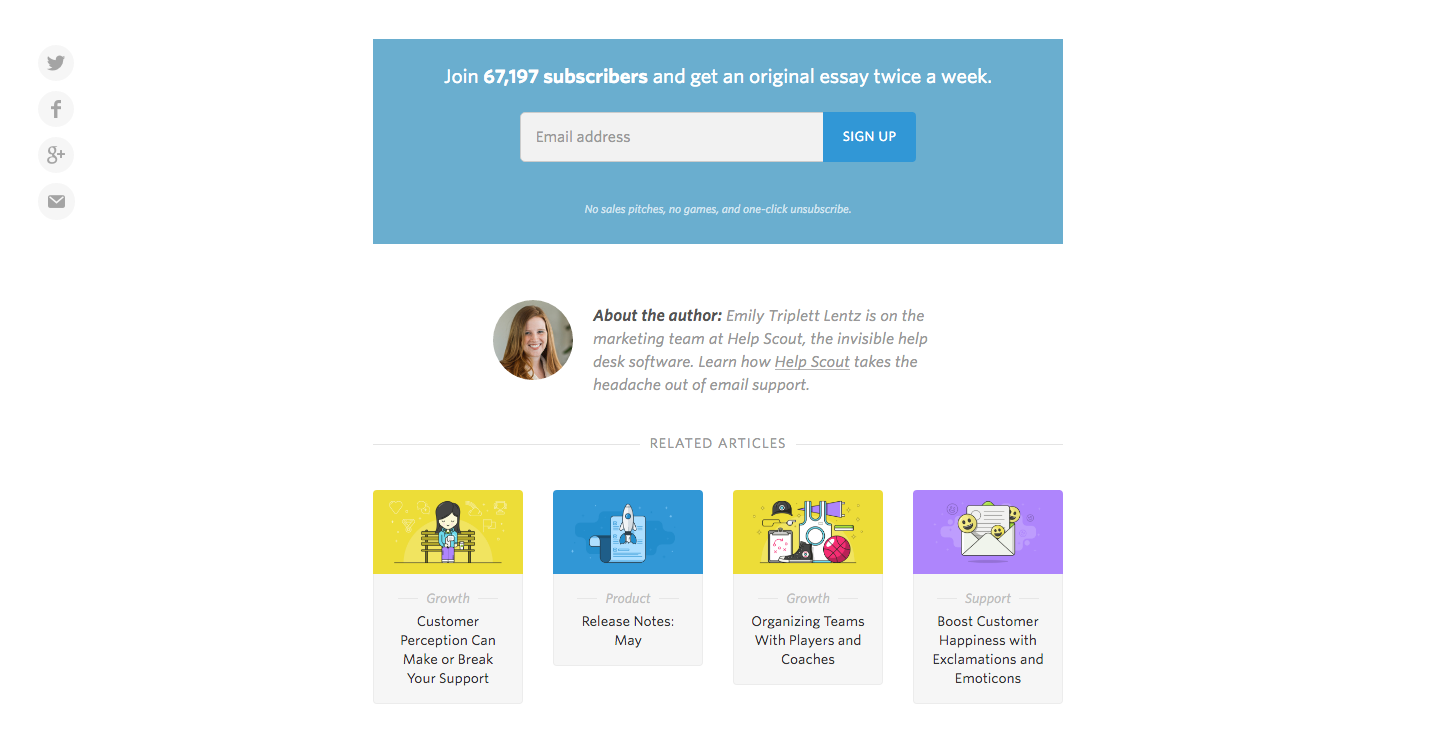
2.4 - Iterating on feedback
Once crafting is over, don't go hitting that publish button just yet. Relax. Let your hot content cool down for a while, at least a few hours. And if you can, try to let a night of sleep pass before diving back in.

Now it's time to review what you’ve created. Add a twist to make the exercise more effective: read it out loud, watch it on a different screen, or print it out. Try and spot the fluff, errors & repetitions. No mercy: send ‘em to the chopping block.
I use Grammarly and Hemingway App to review and trim my content. And I can't help but share this amazing piece on writing by Gregory Ciotti:
Once you've done a first round of personal revision, show your content to relevant team members. Don't be shy: ask for their honest feedback!
If you have a bit of time on your hands, this part's a great opportunity to boost content engagement, as we mentioned earlier. Send it to involved parties (customers, businesses, influencers, etc.) and ask for their early feedback.
Remember: don’t take any feedback personally: you’re creating value for an audience, not for yourself. So drop the ego.
And try to ship often, just like web developers do. It'll help you get past the "damn this isn't a perfect post" feeling. The more you create content, the better you'll get at it.
Conclusion: just do it
Yup, just do it. After all these technical tutorial-ish lines, this advice might sound counter-intuitive. But it's not; trust me. I've only incorporated all of the techniques & tools mentioned in this post over the course of 2-3 years. I got better—and smarter— at it one post at a time. So go ahead and start crafting some content. Don't wait for the perfect plan or strategy. Just get your business' voice out there, ASAP.
I've already published a few resources that could help you with content marketing:
- 25 Free Tools I Use in My Content Marketing Stack
- Content marketing tools & resources (public Gdoc list)
- Content Marketing Plan - Template (public Gsheet template)
I'll be writing the 3rd part of this guide, an overview of content distribution and analysis techniques, in the coming weeks.
The last few months sure made me realize that my own marketing objectives at Snipcart were more time-consuming than I had expected. Still, I don't wish to abandon this side project! As a matter of fact, I'm going to give it a more editorial and personal twist in the upcoming months. Stay tuned. :)
Learned a thing or two here? Enjoyed the examples? If so, would you mind sending a tweet my way? I'd sure love that. Got any feedback or questions? Hit the comments or shoot me an email!
